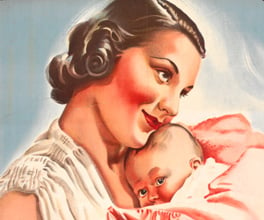The conscription debate
On Sunday 3 September 1939, Prime Minister Robert Menzies declared to the nation that Australia was at war with Germany. Australia was completely unprepared. It had not maintained substantial armed forces during the years of peace.
During World War I (1914 to 1918), Australians had been divided over the question of conscription: should the government have the power to force its citizens into military service?
After the enormous death toll of World War I, a majority of Australians believed that men should not be forced to fight in foreign wars.
The Defence Act 1903 enabled the government to conscript men but only to fight in defence of the Australian mainland. When war broke out in 1939, conscripted Australian troops could not be sent to fight overseas. The government created a separate armed force of men who had enlisted as volunteers and would be free to fight abroad. This was the Australian Imperial Force (AIF), also called the 2nd AIF to differentiate it from the World War I volunteer army:
RECRUITING METHODS – Some army officers believe there is too much ‘stunting’ associated with the recruiting campaign. They think methods employed fail to emphasize the serious realities of war and do not make sufficient appeal to men’s patriotism and high sense of duty.
- The Argus, 27 September 1941
The Argus 27 September, 1941, p 3
The National Library of Australia has provided digital copies of many Australian Newspapers like The Argus: Trove digitised newspapers
Here is what they have to say about the project:
You can contribute to this site by decoding text that the computers have not been able to recognise. This is a relatively new concept in technology called 'crowdsourcing'- a task that would traditionally be done by a company is opened up to a community or the general public.
In this way crowdsourcing is not unlike the war efforts where socks were knitted for the troops and scrap metal was collected to be recycled and turned into armaments.
At the beginning of World War II, direct attacks on the Australian mainland were expected, and the government had no trouble recruiting young men to join the armed forces. Even though Darwin and Sydney would come under Japanese attack in 1942, the sense that Australia was directly threatened was difficult to keep in people’s minds. The government had to work harder to recruit soldiers.
The decision to join the army, navy or air force was not just a private matter. Everywhere they went, young men and women in Australia’s cities saw posters and signs encouraging them to ‘join up’. Despite the seriousness and danger of war, some of this propaganda, like the window displays in large department stores, took a light-hearted approach.
Recruitment drives sometimes used movies, music and sideshow performers to create interest. In World War I, Australian recruitment propaganda had emphasised loyalty to Britain as a reason to fight. In World War II, the propaganda emphasised the defence of Australia itself. Recruits were told that by joining the armed forces, they would be defending their homes and families.
Even after the outbreak of war, politicians still disagreed about the need for conscription. In October 1941, the conservative Prime Minister Robert Gordon Menzies lost office and was replaced by John Curtin of the Australian Labor Party (ALP). Many members of the ALP were strongly opposed to conscription for overseas service, but Curtin realised that to defeat the Japanese, Australian troops would have to be able to fight throughout the Pacific and South-East Asia.
Curtin would have to wait until 1943 for his party to agree that Australian conscript troops could be sent to fight overseas.











